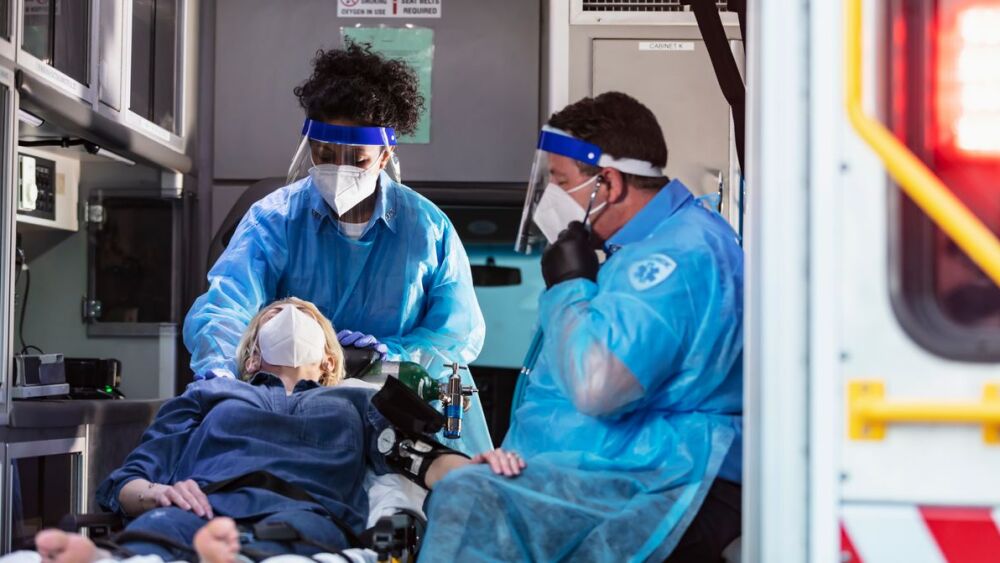Sponsored by
By Laura Neitzel, SAąúĽĘ´«Ă˝ BrandFocus Staff
When a person experiences a stroke or cardiac event, time is of the essence. According to the , every 30 minutes of delay leads to a 10% decrease in the chance of a good outcome.
Reducing the time from onset to treatment can make the difference between improving survival and prognosis or risking patient death or disability. Patient care begins the moment the EMS provider arrives and starts watching the systems, identifying the condition, triaging, communicating with the hospital team and making decisions that can better prepare them to receive and stabilize the patient.
But two key challenges at the prehospital provider level can lead to delays that impact a patient’s chances of survival and recovery:
1. Assessing the type and severity of stroke in a prehospital environment.
2. Finding an appropriate closest (not just closest) hospital with the medical team, equipment and level of care needed to treat the stroke patient.
THE CHALLENGE IN ASSESSING AND TRIAGING STROKE PATIENTS
Multiple stroke assessment scales have been developed to help both prehospital and in-hospital clinicians determine the likelihood of stroke in a patient exhibiting symptoms of stroke. Because “time is brain,” quick and accurate assessment with severity scoring of a stroke is more likely to lead to a better outcome.
While NIHSS scale is used successfully in the hospital setting to determine the severity of stroke and help guide stroke therapy decisions, it measures 15 clinical functions or deficits, so the time it takes to complete may be impractical for the ambulance.
EMS providers in a prehospital setting need to be familiar with a range of stroke assessment scales. While all will measure voluntary muscle use and recognize generalized signs of stroke, they are not all equal in their ability to identify the type of stroke. According to , there is no single gold standard.
Some assessment protocols have more steps and take more time to complete, while others require the provider to make manual calculations or complete checklists. Scales like the Cincinnati Prehospital Stroke Scale (CPSS) or the Rapid Arterial Occlusion Evaluation (RACE) scale are short, simple, easy to remember and avoid the need for calculations – thus making them more feasible in the ambulance.
However, they may miss the specificity needed to identify certain types of stroke, like a symptomatic large anterior vessel occlusion (sLAVO, or simply LVO), which might require the patient to receive endovacscular (EVT) treatment at a comprehensive stroke center.
This can become a critical issue for patient outcomes.
According to a , the difficulty in reliably identifying sLAVO can cause delays in patient care.
“Because sLAVO cannot be reliably identified in the ambulance, patients suspected of acute stroke are often transferred to the nearest hospital (often a PSC) to start IVT as soon as possible. For patients with sLAVO, this routing leads to a median of 60 to 109 minutes’ delay due to interhospital transfers, with associated worse functional outcomes. Prehospital identification of patients with sLAVO enabling direct allocation to a CSC would greatly reduce delays to EVT treatment and improve clinical outcomes.”[1]
Triaging and identifying the stroke type according to stroke assessment and prediction scales is only the first challenge. The second is getting the patient to a medical facility with the appropriate team and resources in place – in accordance with local protocols that may or may not allow the EMS provider to bypass the nearest hospital in favor of one with the right resources.
´ˇł˘ł˘˛Ń’s helps to solve both of these challenges.
MAKE ASSESSMENT MORE ACCURATE AND TRIAGING QUICKER
The from ALLM helps EMS providers quickly and accurately triage patients and ensure they receive the care they need as quickly as possible.
JoinTriage solves and speeds up the triage challenge with the power of artificial intelligence. Within two minutes, the app walks the user through a new set of protocols (developed by ALLM in clinical association with Grady Memorial Hospital and Emory University) that combine features of NIHSS, as well as other major assessment scales used by EMS providers, including FAST, VAN, RACE and CPSS.
The responses are then used to evaluate symptoms and summarize the patient’s condition with a numerical score. The score is accompanied by other useful information, such as the probability of severe outcomes.
Having one decision support engine that encompasses other protocols makes it easier, faster and more feasible for EMS providers to triage and identify various types of stroke in the ambulance, including sLAVO, so providers can make more consistent, data-driven decisions and get the patient to the right kind of facility without delay.
REDUCING DELAYS IN TRANSPORT
When a patient’s condition has been assessed and a score provided, the JoinTriage app will display a map showing the locations of recommended medical centers best suited to treat the patient.
The crown jewel in the is its database that currently lists all hospitals and medical facilities in the U.S., along with their certifications and capabilities, filling a huge knowledge gap. ALLM is expanding this database to include urgent care centers, primary care offices, nursing homes and other alternative destinations that may be available to EMS providers under the .
The app is also configurable to the requirements of the jurisdiction, so you don’t need to worry about going afoul of local or regional rules, protocols, and restrictions.
COMPLETE THE CONTINUUM OF CARE
In addition to putting a more powerful stroke assessment tool in the hands of EMS providers, JoinTriage also helps them communicate with and coordinate resources at the destination hospital.
By integrating with , ´ˇł˘ł˘˛Ń’s communication app for hospitals, JoinTriage enables EMS providers to share patient information with the destination hospital via Join chat, giving medical teams at the destination sufficient time to prepare for optimal treatment. They can even do tele-EMS consults while the patient is enroute to the hospital. Further, EMS crew can benefit by receiving the real-time feedback from clinicians directly, thus EMS agencies becoming learning organizations with continual improvement.
A recent study conducted in Vermont, published in The American Journal of Emergency Medicine, shows that the stroke assessment scale, . The study also highlights the significance of JoinTriage used by EMS when integrated with the Join app at the hospital level can improve the standard of stroke care, including effective pre-notifications.
“Patient-centered quick and appropriate care is paramount in emergency situations,” said Harry Reddy, chief executive officer of ALLM. “We’re excited to see the innovative and clinically-proven JoinTriage/Join app suite helping transform EMS care for the benefit of patients and providers at point of care and communities at large.”
In the race against time, EMS providers have a new advantage – JoinTriage.
currently has over 35,000 registered users. It is free to EMS providers and available for both iOS and Android devices.
For more information, visit .












